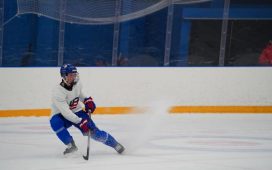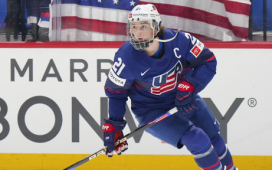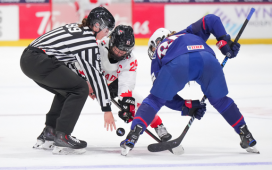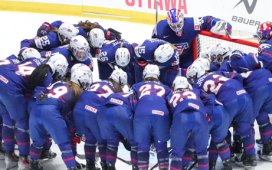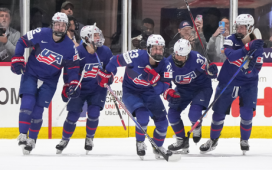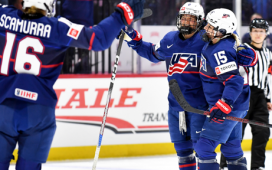The break is over, the festivities are complete and now it’s time for the NHL’s 31 clubs to start hunkering down for the home stretch. And with the trade deadline on the horizon – we’re less than one month away – and the battle for post-season positioning set to heat up, each passing game will increase in its importance.
But which teams will make the biggest moves in the coming weeks? And which clubs have potential to fall apart at the worst possible time? Here’s a look at six teams – three risers, three fallers – who could make a move in the standings in the weeks to come:
RISE
Calgary Flames
In the time since Geoff Ward stepped behind the Flames’ bench, Calgary has seen a significant improvement in its results. To wit, with Bill Peters at the helm, the Flames had a .481 points percentage, and Ward’s tutelage has seen Calgary increase that rate to .674 percent. How does that stack up against the top teams in the league? Since he first stepped into the top job in late November, the Flames have the fifth-best points percentage in the entire NHL.
What gives further reason to believe Calgary can make a push up the Pacific Division standings and secure itself a comfortable spot in the post-season, though, is that the Flames have been a top-15 team in expected goals percentage since Ward’s hiring. Calgary has done better at insulating its crease under Ward. Add in that the Flames have the fifth-weakest remaining schedule based solely on points percentage and the table seems to be set for a second-half surge.
Tampa Bay Lightning
It had become clear heading into the all-star break that the Bolts were back. The Lightning have been playing some of the best hockey of any club in the NHL and Tampa Bay was already beginning to push up the Atlantic Division standings as they headed towards the mid-season exhibition. There’s reason to believe their fortunes could improve further, too. Consider that the Lightning boast some of the best underlying numbers in the NHL – a 55 percent expected goals percentage and fifth-best Corsi percentage (52.8) among them – and are heading into the post-break schedule with one of the easier slates in the league. In fact, only four teams have a weaker schedule than the Flames, one of which is the Bolts.
Beyond metrics, though, it’s indisputable that Tampa Bay boasts one of the most talented top-to-bottom groups in the NHL. The breadth of talent on the Lightning roster can overwhelm even the best opposition on any given night. That they were starting to get rolling heading into the break should strike fear into the rest of the Eastern Conference.
Toronto Maple Leafs
The return of Jake Muzzin, who is set to return to action Monday after missing the past 10 games, couldn’t come any sooner for the Maple Leafs. But getting back one of the team’s top defenders isn’t the sole reason Toronto is primed to take a step forward.
Despite modest success leading into the break – five losses in six games, including blowout defeats at the hands of the Florida Panthers and Chicago Blackhawks – the Maple Leafs have been among the league’s best teams in terms of driving play and tilting the ice in their favor. Toronto would undoubtedly benefit from better suppressing opposition opportunities, which would in turn give Frederik Andersen the opportunity to find his form.
The other benefit for the Maple Leafs is a fairly friendly schedule. Only eight teams will play a caliber of opponent with a lower average points percentage the rest of the way. Of the 33 games left on Toronto’s schedule, 15 are against opponents who aren’t currently in a post-season position.
FALL
Nashville Predators
By virtue of points percentage, the Predators aren’t actually as far out of the final Western Conference wild-card spots as they may appear. Despite sitting six points back of the Arizona Coyotes and Vegas Golden Knights with three points separating Nashville from the conference’s last playoff berth, the Predators actually boast the ninth-best points percentage in the West and have five games in hand on the Golden Knights and four on the Coyotes. There’s room to make up ground.
There’s reason to be skeptical about their ability to do so, however, in large part because they’re facing one of the toughest groups of opponents in the league down the stretch. In fact, the average points percentage of the Predators’ remaining opponents is the third-highest in the NHL. The overall performance of the goaltending hasn’t really improved all that much under coach John Hynes, either, and the offense is currently experiencing a bit of a dry spell with two or fewer goals in each of its past four games.
The hole the Predators dug themselves might be too deep and the tough schedule the rest of the way could prove difficult to overcome.
Edmonton Oilers
This should be prefaced by saying that “fall” doesn’t necessarily mean out of a playoff spot entirely, but slipping out of a divisional spot and having to scratch and claw to earn a wild-card berth seems all too possible for the Oilers.
The suggestion, particularly when the Flames are on the other side of the spectrum, is sure to raise the ire of some Edmontonians, but it wasn’t made without consideration of a few factors. As is the case with others on this list, the Oilers’ strength of schedule, which is tied with the Vancouver Canucks’ for 14th-most challenging, is one thing to take into consideration. What also must be taken into account, however, is that Edmonton has had the sixth-lowest expected goals percentage in the NHL over their past 25 games, a rate in line with the New York Rangers, Chicago Blackhawks and New Jersey Devils. That said, it’s also a rate ahead of that of the Canucks.
So, why does Edmonton appear here and Vancouver does not? Goaltending. Among the 40 goaltenders with 500 minutes played at 5-on-5 across their team’s past 25 games, Mikko Koskinen and Mike Smith rank 35th and 37th with .904 and .903 save percentages, respectively. Canucks starter Jacob Markstrom ranks 18th with a .924 SP. The crease can be the ultimate difference-maker.
Winnipeg Jets
Speaking of performance over the past 25 games, the Jets’ has been abysmal. Only five teams have a points percentage lower than Winnipeg’s and the underlying numbers are unsightly, to say the least. The Jets’ shot share and attempt share is among the lowest in the league, while Winnipeg also has the lowest scoring chance percentage, high-danger chance percentage (by a mile) and league-worst expected goals percentage. To put that last one into perspective, the Jets’ 41.9 expected goals percentage across their past 25 games is nearly 2.5 percent worse than the mark of this season’s potentially historically awful Detroit Red Wings squad.
The concern, too, is that early season Vezina Trophy frontrunner Connor Hellebuyck is starting to fade. After posting a .933 SP in his first 21 appearances, he has a .901 SP in his past 21 outings. It’s difficult to blame Hellebuyck for his declining numbers, though. He’s under greater duress than just about any netminder in the NHL. We’ve made mention of it recently, but if Winnipeg can’t clean up their own-zone play in a hurry, their playoff aspirations are going to fall by the wayside.
(Strength of schedule information via NHL.com)
(All advanced statistics via NaturalStatTrick)
Want more in-depth features, analysis and an All-Access pass to the latest content? Subscribe to The Hockey News magazine.
